
Gueuzerie Tilquin
There are few circles of brewing so exclusive that most serious beer enthusiasts could recite their membership from memory. One is the roll call of Trappist breweries, currently seven strong (though shortly to increase to nine). Another, slightly longer, is the list of artisanal lambic producers in and around Brussels, the dedicated band that creates some of the world’s finest and most complex beer using some of its most primitive brewing methods. Once, lambic brewing was ubiquitous in the region, but post-World War II the industry appeared to be in terminal decline. Developing international appreciation of beer in the 1970s and the 1980s saw the list of surviving artisans stabilise, though it’s rarely grown since. Until May this year, De Cam was the most recent addition, in 1997. But now connoisseurs have a new name to learn: Gueuzerie Tilquin.
Like De Cam, Tilquin is a maturer and blender rather than a brewer. Lambic techniques are such that, though the initial contact with wild yeast is a key defining feature of the style, many of the crucial processes that contribute to the distinct character of the final result begin immediately after this seeding, when the beer undergoes lengthy fermentation in wooden casks, usually followed by blending and sometimes steeping with fruit (see my article on the Toer de Geuze for more details). In many cases the entire process takes place within a single enterprise, but there’s also a longstanding custom of taking day-old wort, already infected with wild yeasts, by tank to a separate business for maturation and blending, resulting in beers with their own signature, distinct from the brewer’s own versions.
In the Pajottenland, the rural heartland of the style west and southwest of Brussels, it was relatively common for local pubs to mature and blend their own lambic, alongside a few independent standalone blenders, the lambic equivalent of the Burgundy négociant or the blender and bottler of Scotch whisky. Tilquin joins four current blenders, only one of which is a surviving historic independent.
Behind the new venture is 37-year-old Pierre Tilquin. His name, pronounced in the French with a nasalised final vowel (‘Till-KAN’), derives from tilleul, ‘lime tree’, explaining the arborial silhouette that now serves as his company logo. Despite his relatively young age, Pierre boasts impressive experience of both lambic and conventional brewing. He trained as a bio-engineer, earning a doctorate in statistical genetics at Louvain-la-Neuve, then decided to turn towards a “more concrete and passionate” occupation. Just up the road from Louvain, but on the other side of Belgium’s language boundary, he took a 15-day course in malting and brewing science at K.U.Leuven (Catholic University of Leuven). Both universities share a tradition of excellence in brewing science, unsurprisingly as Leuven also happens to be the home town of what’s now the world’s biggest brewer, Anheuser-Busch InBev.
After a stint of just over a year at Huyghe, of Delirium Tremens fame, in Melle, Pierre was drawn to the lambic industry, first at pub-blender-turned-brewer-turned-blender 3 Fonteinen in Beersel, then at the legendary Cantillon in Brussels itself. It’s an interesting career path for someone with a background in hard applied science, indicating an obvious thirst for constant challenge. Of course in a very real sense brewing is a form of bio-engineering, but lambic is of necessity the closest to traditional craft, consciously rejecting many of the techniques of control that conventional industrial brewers take for granted.
Pierre’s next step, setting up his own lambic business, threw up a challenge of a different kind, and one which very few others were willing to meet, helping explain why, though there’s now a significant worldwide demand for artisanal lambic beers, new producers emerge so infrequently. A top quality geuze, the lively blend of old and young lambics that is seen as the true test of the lambic producer’s art, requires supplies of beers matured over one, two and preferably three summers.
“My business plan was unusual,” says Pierre. “For the first two years all I could do was spend money, without being able to sell anything.” He bought his first worts in March 2009, and sent his first beers to market in May 2011. That’s an extraordinary test of commitment and confidence, not only for the owner of a business but also for his or her investors: explaining the long wait for a return on the investment to a bank manager would be challenging enough in boom times, let alone in the current economic environment. Pierre has already been criticised by some lambic aficionados for taking the “short cut” of blending a geuze at just over two years, but it’s difficult to see how he could have got up and running otherwise.
The financial challenges also partly explain another remarkable fact about the new arrival. Despite the French-sounding names of some of the best known brands, lambic brewing today is largely a Flemish occupation. All the established producers are in Dutch-speaking Flanders, except for Cantillon in the officially bilingual Brussels Capital Region, in the decidedly Flemish-tinged western suburb of Anderlecht. Tilquin, by contrast, has been set up on the other side of the language boundary in Wallonia, in an isolated industrial unit on the N7 main road in the hamlet of Bierghes, Walloon Brabant, not far from Enghien. Though fluent in both languages, and in English, Pierre himself is francophone by birth, from Namur, and the marketing makes a certain virtue of the French language, coining the term ‘gueuzerie’ as an equivalent to the Dutch ‘geuzestekerij’ for an independent non-brewing lambic blender.
But his choice of location had less to do with ethnic pride than with economics. Wallonia is generally the poorer of Belgium’s two major regions and offers subsidies and tax breaks to new enterprises that aren’t available in Flanders: in fact the Walloon regional government has invested so heavily it owns a quarter of the business. Another quarter is held by a private investor, while the well-respected Rulles brewery in Belgian Luxembourg has a small stake. The rest is in the hands of Pierre and his family.
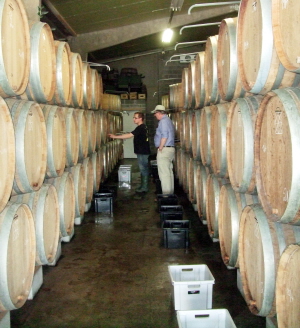
Rows of French oak wine casks at Gueuzerie Tilquin. Spot the lambic blender and the Belgian beer guru.
Like other such establishments, the bulk of the space is packed with large wooden barrels, in this case 220 former wine casks from Bordeaux (Saint-Estèphe and Saint-Emilion) and the Rhône valley (Hermitage, Cornas and Crozes), all of which have previously been filled with wine three or four times. There are none of the monster barrels found in some lambic facilities – all Tilquin’s are a standard 400l. But they still make for a mouthwatering sight, tantalisingly chalked with traditional symbols identifying the brewer, and the brewing date. Some of the newer ones are still oozing yeasty barm from their bungs – lambic is the only commercial beer that undergoes the vast majority of its primary fermentation in wooden casks, as well as ageing in them. The wood might be relatively new but the design and concept is ancient, and even in this modern concrete warehouse the barrels seem to resonate with centuries of craft.
The beer inside the barrels comes from four different producers: alongside Boon, Lindemans and Girardin, Pierre is privileged to have secured supplies of Cantillon lambic, which is rarely sold on to others for blending. The total capacity is 500hl per year, but only 200hl will go to market this year, and 400hl next, ensuring the stock progressively ages, so next year that all-important three-year-old lambic can be present in the blend.
When I visited, with renowned Belgian beer expert Tim Webb in early May 2011, Pierre was gearing up for his first open day at the end of May and the official launch of his oude geuze, or gueuze a l’ancienne as he prefers it, aged six months in bottle after blending. We were treated to a taste of this traditional sparkling lambic, and despite the relative youth of the component beers, it was already demonstrating notable finesse. Excitingly, Pierre also picked out casks of single unblended lambics for us to sample, including Boon’s low gravity Meerts, which is used almost exclusively in blends and fruit beers.
Besides the bottled geuze, available in both 375ml and 750ml sizes, blended but unrefermented lambics and faro are being released to selected outlets and festivals, and fruit beers are planned too. Much more unusual is a draught geuze making significant use of the Meerts, refermented for three months in tall 20l kegs for Belgian pubs and 30l KeyKegs for export. Indeed US importers have already pre-ordered much of Tilquin’s stock: the gueuzerie expects to sell 40% of its products in the USA, with 30% to the Belgian market and the remainder to Italy, the rest of Europe and Japan.
The draught geuze is proving a popular novelty even in the local market, but has provoked a further controversy, as some experts insist geuze has to be bottled by definition. Some brewers even claim it is technically impossible. “The keg and bottled products are different, and I don’t call my draught geuze ‘gueuze à l’ancienne’ [oude (old) geuze, the official designation for the most artisanal bottled products] as by law that has to be in bottle. Personally I consider a keg to be nothing more than a big bottle. If I put geuze in a 15l nebuchadnezzar it would be considered gueuze à l’ancienne, so why is it no longer geuze if I put it in a 10l keg?”
The gueuzerie is only Wallonian by a few hundred metres. Its entrance looks out over rolling fields where horses roam. Pierre points into the middle distance, across the railway line to some woods on a low ridge. “That’s the Pajottenland, in Flemish Brabant,” he says, “and we’re still in the Senne valley, closer to the river itself than some other producers.” The legal definition of lambic has no geographical restrictions. But whether or not HORAL, the artisanal lambic brewers’ trade association, agrees to admit Tilquin to its ranks remains to be seen, as Pierre’s application for membership is still up for debate.
As anyone familiar with Belgian society will know, linguistic geography matters in a country that has now spent over a year attempting unsuccessfully to form a government after a general election in June 2010 and now holds the world record for post-election stalemate, as politicians representing the distinct speech communities fail to agree on the common interest of the country as a whole. It’s often said that beer culture is one of the few things that unites Belgians, and while that’s true to a certain extent, craft beer promotion and appreciation still tends to take place in monolingual silos.
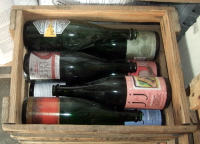
Discarded bottles of other people's lambics at Gueuzerie Tilquin, demonstrating great taste and discernment.
Currently, of course, Pierre is not attempting to brew the base lambics himself, but you can’t help thinking that next challenge will come round at some point. “From a technical point of view,” he says, “I think it’s possible to produce lambic outside the favoured geographical area, as it’s above all a question of the buildings and the equipment becoming colonised with adequate microflora through successive brews. As a blender, I don’t have to face this problem as I buy my wort already seeded with wild yeast from lambic breweries. So the yeasts will progressively install themselves in my barrels and in my building.
“Besides,” he smiles, looking across to the woods again as if beckoning the yeast spores in, “I don’t believe that Brettanomyces bruxellensis and lambicus stop at the language boundary and only speak Dutch.”
Beer picks
- Boon Meerts (Tilquin) 4% Lembeek, Vlaams-Brabant, Vlaanderen
- Lindemans Oude Lambik 2 jaar oud (Tilquin) 5% Vlezenbeek, Vlaams-Brabant, Vlaanderen
- Tilquin Gueuze à l’ancienne 2011 6% Rebecq-Bierghes, Brabant-Wallonie, Wallonie
Website: www.gueuzerietilquin.be
Thanks to Tim Webb for inviting me to join him on this visit.



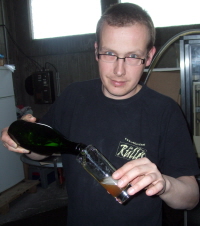

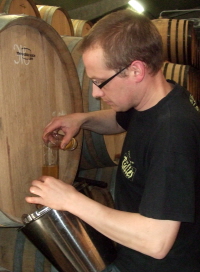
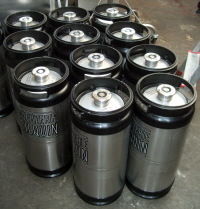


[…] Des de Moor on Tilquin, a new Geuze producer in the French speaking part of Belgium. […]
wow – a new geuze brewer? exciting! nice profile, Des.
Not a brewer, Leigh. A blender.